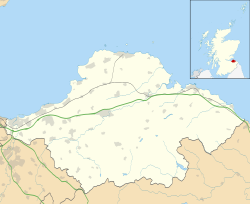History
The foundation of Drem as an airfield, precedes the creation of the Royal Air Force (RAF) as by 1916, an airfield had been established under the name West Fenton Aerodrome. From 1916 to 1917, No. 77 Home Defence Squadron, Royal Flying Corps operated from Drem and in April 1918, No. 2 Training Depot Station opened.
Between April and 14 August 1918, the American 41st Aero Squadron under the command of Lieutenant Warren C. Woodward was temporarily located at Drem together with an aero repair flight company. The Americans called the airfield "Gullane" in its official history. The squadron transferred to St Maixent in France and arrived at its operational airfield of Romorantin on 29 August 1918.
By November 1918, West Fenton had been renamed Gullane Aerodrome and with the post-war demobilisation the airfield was vacated in 1919. From 1933 to 1939, the airfield saw only occasional use by visiting squadrons.
It was at this time, while stationed there in 1934, that Victor Goddard had his paranormal vision of the airfield as it might appear in the then future 1939. [2]
In 1939, the grass airstrip was resurfaced, and the unit was renamed RAF Drem. The station was then home to No. 13 Flying Training School.
Following the outbreak of the Second World War, RAF Drem became an air defence fighter unit for the city of Edinburgh and the shipping area around the Firth of Forth, with Supermarine Spitfire of 602 Squadron posted to Drem.
On 16 October 1939, the Luftwaffe made its first attack on Great Britain. Junkers Ju 88s of 1/KG 30 led by Hauptmann Helmuth Pohle attacked British warships in the Firth of Forth. Spitfires from 603 Squadron (City of Edinburgh Squadron) joined 602 Squadron aircraft in a defensive counter-air sortie. Following the destruction of a Luftwaffe bomber aircraft by a 603 Squadron Spitfire, 602 Squadron pilot Flight Lieutenant George Pinkerton gained the second kill of the Second World War.
In 1940, an airfield lighting system for night landings, the Drem Lighting System, was developed at RAF Drem.
Royal Australian Air Force 453 Squadron was re-established at Drem on 18 June 1942, equipped with Supermarine Spitfire aircraft, and joined the RAF's Fighter Command. [3]
Royal Navy
In 1942, a request for lodger facilities for the Royal Navy at RAF Drem was granted and Royal Naval Air Section Drem became home to 784 Night Fighter Training Squadron. On 21 April 1945 the airbase was transferred from No. 13 Group, on loan to the Admiralty, known as Royal Naval Air Station Drem (RNAS Drem) and was commissioned as HMS Nighthawk. Its primary role was Naval Night Fighter School and Night Fighter Direction Centre. 770 Fleet Requirements Unit had moved from RNAS Dunino in July 1944 and in May 1945 732 Night Fighter Training School formed at RNAS Drem. A number of Fleet Air Arm squadrons used the airbase when disembarking from aircraft carrier operations between 1943 and 1945. March 1946 saw the airfield transfer back into RAF control, [4] and the unit was returned to the Air Ministry although it was closed and then decommissioned not long after that.
Units and aircraft
(Sources:)
The following units were here at some point: [7]
Most of the units based at Drem during the Second World War were fighter or night-fighter squadrons, which were often based at Drem for relatively short periods. This was typical of many fighter stations in Scotland and Northern England as although Luftwaffe activity in these areas was relatively limited for most of the war, they still required to be defended. Squadrons would therefore be rotated north to cover "quiet" sectors whilst also resting, absorbing replacement aircrews and/or converting to new aircraft. As the war progressed the Luftwaffe threat to Britain diminished further and surplus fighter stations could be transferred to other uses, such as (in the case of Drem) training of Fleet Air Arm crews.
In addition to the units and dates listed above, Drem also hosted detachments from various other RAF squadrons from time to time. These were mostly fighter and night-fighter units, but detachments from 278 or 281 (Air-Sea Rescue) Squadrons were also present for extended periods during 1942 and 1943.
Current use
At present, the RAF Drem Museum is housed in what was RAF Drem's mess accommodation.
Various business premises occupy the rest of the accommodation section of the airfield.
Equestrian activities occupy areas of the greater airfield.
A radio controlled model flying club have a strip on the southern edge of the field just off the peritrack.
This page is based on this
Wikipedia article Text is available under the
CC BY-SA 4.0 license; additional terms may apply.
Images, videos and audio are available under their respective licenses.


